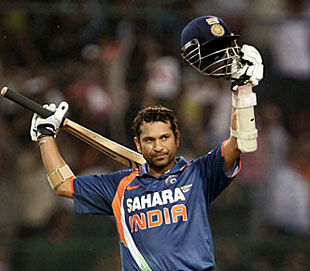Now that the paeans praising the demigod of cricket for achieving the so-called 100th 100 have been sung and the effervescence of celebration almost subsiding, it is good time to pay attention to the retirement issue. It is well-known that the Little Master has rubbished everyone suggesting his retirement after reaching the milestone. He conveyed the message, “Yeh dil mange more”. He thinks he has a lot more to offer. Though I have high regard for him, I don’t agree with him in this respect. In my opinion, he should retire because of the following reasons:
1.
Last one year’s poor performance: From 28.3.2011 to 28.3.2012 (the date of writing this blog), Sachin scored only 418 runs from 12 odis, averaging only 34.83 (this poor show has brought down his average from 45.13 to 44.83). Averaging 34.83 in the prized opening slot with a strike rate of 81 is, by no means, the work of a god. During this period he scored only one hundred against Bangladesh with a dismal strike rate of 77.55, resulting in India’s defeat. Judging from his pathetic strike rate from 90 to 100, there is reason to believe that India’s win was not his primary consideration.
Last one year’s poor performance: From 28.3.2011 to 28.3.2012 (the date of writing this blog), Sachin scored only 418 runs from 12 odis, averaging only 34.83 (this poor show has brought down his average from 45.13 to 44.83). Averaging 34.83 in the prized opening slot with a strike rate of 81 is, by no means, the work of a god. During this period he scored only one hundred against Bangladesh with a dismal strike rate of 77.55, resulting in India’s defeat. Judging from his pathetic strike rate from 90 to 100, there is reason to believe that India’s win was not his primary consideration.
During the same period, he played 11 tests, scoring 778 runs with an ordinary average of 37.04 (this performance has brought down his career average from 56.94 to 55.44). During the same period, Rahul Dravid played 14 tests scoring 1225 runs with an average of 51.04. While Sachin failed to score a century, Dravid scored 5 centuries in the last one year. The irony is that Sachin thinks he is on top.
2. Responsibility as the senior most player for team’s horrible overseas performance: India’s last two overseas series of England and Australia cannot be called anything but nightmares. Blaming a particular person for this dismal show will not be proper, as cricket is a team game. But as the most senior pro in the team, he should take the maximum blame. His one or two good innings could have turned things in India’s favor. But he failed repeatedly to make a century. Previously, he had been playing odis selectively against stronger teams. But repeated failures and greed for making the 100th ton had gone into his head, making him to block a place for the deserving juniors in the Asia cup odi side. At that juncture, some section in the media predicted that he would retire after scoring the 100th ton. Clearly, they failed to understand the psychology of the Little Master. I am quite sure he has the 50th 100 in odis in his mind.
3. Lack of motivation: Sachin claims he is madly in love with cricket. Even his worst critic will not disagree with this statement. Love for cricket is essential for any successful cricketer. But the bigger factor is motivation. Recently, in an interview, Sachin said that he has no more targets to play for. Clearly, targets were his motivation, and there are no more targets to chase. Also, after participating in 188 tests and 462 odis for long 23 years, he can be compared with a squeezed lemon with very little juice left inside. So, instead of pressing the lemon harder, it should be placed in the basket of peaceful retired life.
4. Age factor and injuries: Tennis elbow took a heavy toll on Tendulkar. When he recovered from it, he was just a shadow of his former self. The injury turned him from a beautiful stroke player to an awkward accumulator of runs. This is precisely the reason for his failed centuries (since 2004, Sachin has scored 13 odi hundreds out of which on only 5 occasions India has won). He was one of the main culprits for India’s shameful exit from the odi World Cup 2007 in West Indies (he had scores of 7 against Bangladesh, 57 not out against Bermuda and 0 against Sri Lanka). At that time some commentators called for his retirement. But the public opinion was not that vociferous. Now, he is 39 years old (born on 24 April 1973), even though he thinks he is 37. He has been getting bowled frequently (even by the rookies), indicating a decline in reflex and eyesight. Therefore, it is high time for him to go.
5. Blocking young talents: After repeated failures of the old warhorses during the recent overseas tours, Gavaskar argued that had the juniors played in place of them, they would have gathered vital experiences for the future. Also, they could not have performed worse than these guys. It can be argued that the juniors have to earn their place in the team. Pujara, Tiwary, Rahane etc. have been doing very well in the domestic arena. Tiwary was denied any match even after scoring a century in his last one day international match. The problem with Sachin is that he has reached such a legendary status that the selectors do not find enough courage to tell him that it’s time to hang up his boots. So, until the he decides it’s enough for him, a deserving youngster has to cool his heels.
6. Strong public opinion for his retirement: A glimpse of the public opinion can be found from the comments written in Internet. Not only in the net, but also in public places, people are talking about his retirement. Even his ardent fans have become disgruntled with his lackluster performances, and they want him to retire. Former greats like Kapil Deb and others have also suggested him to retire. But Sachin is so enamored with his records that he simply cannot gauge the public mood.
7. Chances of declining record: I have shown in the first reason paragraph that how his performance has been declining and how it affects his record. As Indians, we feel proud about his record. If the decline in the averages continues its down slide, we will definitely feel sad.
8. More important role to play for cricket: It is time for him to contribute to the development of Indian cricket in other capacities. He can become the coach of the under 19 team or he can play any important role in the NCA, or he can do anything for the betterment of cricket.
9. Shameful current ICC ranking: Can you believe that the “God of cricket” is placed at 27th position in the current ICC ranking for the odis? This is shameful, and should be enough reason for him to call it a day.
10. Pay attention to the other aspects of life: Like Rahul Dravid’s case, it’s time for Tendulkar, too, to pay attention to his family. He could not pursue higher education because of cricket. Does he want his son and daughter to be also like him? Isn’t it time to personally look after the family?
Sources of information: Wikipedia and ESPN cricinfo
Picture from the Internet
Picture from the Internet


